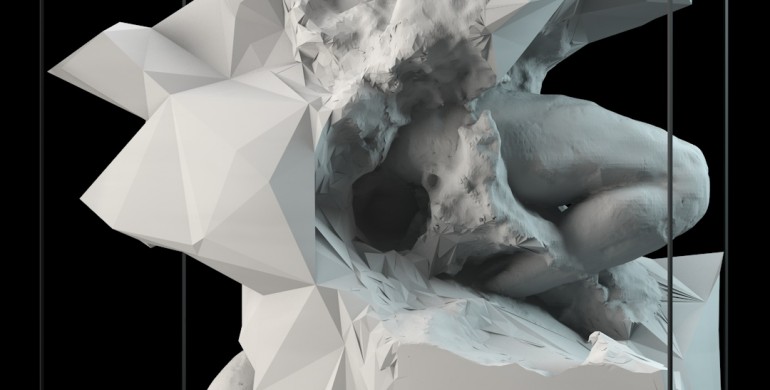Introducing: Quayola
The headliner for Coded Matter(s) #3: Transmaterials in none other than Quayola (1982, Italy), the artist behind the exhibition The Sculpture Factory, currently on display at MU. Transmaterials will be the closing event of the exhibition, providing a unique chance to delve deeper into the literal matter of code, true to our series’ name.
Quayola is a visual artist based in London. He uses contemporary digital technology to tackle classic aesthetics and the universal rules for beauty and perfection. An exemplary work in this style, fusing contemporary and classical, can be seen in his work Strata #2. For this work commissioned for Nemo Festival in Paris, Quayola investigated the improbable relationship between digital aesthetics and the icons and art of a cathedral’s stained glass windows. Until now he mostly created these studies in the form of projections, installations, photography and multimedia adaptations. However, for The Sculpture Factory, which he developed especially for MU, he is entering the realm of sculpture.
Captives – Robotic Milling from Quayola on Vimeo.
The basic material is provided by none other than his great example Michelangelo: the unfinished series of four ‘Prigioni’, or ‘Captives’, made between 1513 – 1534. To these sculptures and Michelangelo’s ‘non-finito’-style (meaning literally: unfinished) the exhibition serves as an hommage. Pioneered by Donatello and later used by Michelangelo and many others, a ‘non-finito’ sculpture is one left unfinished due to the artists’ own sense of lacking in expressing his intellect or creative idea. This sense of artistic struggle was epitomised in the unfinished ‘Captives’ and also an aspect transferred by Quayola into his rendition, as he does not only rework Michelangelo’s work with modern tools into new physical sculptures through software, scanning and 3D-printing techniques, but also explores deeper layers of the process and final product by adding performances, sound and other media to provide a more complete image of the various aspects of creation and expression of the code as matter and the matter as code.
For this project, Quayola worked as the director, collaborating with others to produce the required software and techniques. This is typical for his style, as he also works as a visual artist and graphic designer, constantly collaborating with and blurring boundaries between a range of other disciplines, from musicians to animators, from programmers to architects.
Quayola’s work has been exhibited at the Venice Biennale; Victoria & Albert Museum, London; British Film Institute, London; Park Ave Armory, New York; La Gaite Lyrique, Paris; MNAC, Barcelona; Grand Theatre, Bordeaux; Palais des Beaux Arts, Lille; Paco Das Artes, Sao Paulo; Triennale, Milan; Sonar Festival, Barcelona; Elektra Festival, Montreal and Clermont Ferrand Film Festival.
